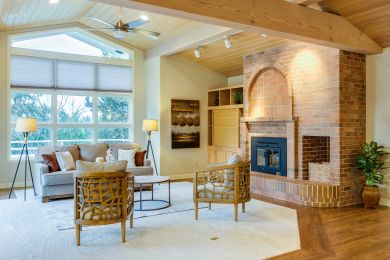Do you know the 3 main types of Lighting?

There are several options you should consider when selecting the type of lighting you are going to use in your home. However, there are 3 fundamental categories that you cannot ignore. Discover in today's article the main types of Lighting you should know about.
A division can have multiple purposes. It can be a place to relax, work, study, do crafts, cook, share a meal with family or friends and much more... the tasks or activities that will be performed therein. Each type of lighting plays a role and is critical to the end result of your lighting project.
Ambient Lighting
General or ambient lighting is intended to illuminate a room in its entirety, being the main source of lighting. This provides an even level of lighting throughout the space, independent of other lighting sources.
Its main objective is to replace natural lighting and create ample lighting that illuminates as much space as possible, ensuring a safe and easy path in the room. Products used for general lighting can range from recessed spotlights to pendant lamps.
Task Lighting
Task lighting - as the name implies - provides lighting to help us perform specific tasks such as reading, cooking or studying. Task lighting is more localized than other types of lighting and its function is to illuminate a particular work area, providing enough contrasting light to increase our productivity.
Task lighting must be free of glare and shadows and must be bright enough to avoid eye strain and must be selected based on the task at hand. Some examples of task lighting are table lamps, desk lamps and lighting over the kitchen counter.
Highlight Lighting
Accent lighting is primarily used to highlight a specific point of interest. This type of lighting is more focused on design and decoration than the other two types of lighting.
The main function of accent lighting, as opposed to general lighting, is to create a focal point for the room, attracting your eye and adding a greater dimension to the room. This type of lighting is often used to highlight an architectural feature or sculpture, to enhance the beauty of photographs or paintings, or to enhance the texture or color of walls.
As a general rule, effective accent lighting requires three times as much light to be installed at the focal point as ambient lighting and is usually provided through gutters, under cabinet or shelf lighting, light molding or wall fixtures.
A division can have multiple purposes. It can be a place to relax, work, study, do crafts, cook, share a meal with family or friends and much more... the tasks or activities that will be performed therein. Each type of lighting plays a role and is critical to the end result of your lighting project.
Ambient Lighting
General or ambient lighting is intended to illuminate a room in its entirety, being the main source of lighting. This provides an even level of lighting throughout the space, independent of other lighting sources.
Its main objective is to replace natural lighting and create ample lighting that illuminates as much space as possible, ensuring a safe and easy path in the room. Products used for general lighting can range from recessed spotlights to pendant lamps.
Task Lighting
Task lighting - as the name implies - provides lighting to help us perform specific tasks such as reading, cooking or studying. Task lighting is more localized than other types of lighting and its function is to illuminate a particular work area, providing enough contrasting light to increase our productivity.
Task lighting must be free of glare and shadows and must be bright enough to avoid eye strain and must be selected based on the task at hand. Some examples of task lighting are table lamps, desk lamps and lighting over the kitchen counter.
Highlight Lighting
Accent lighting is primarily used to highlight a specific point of interest. This type of lighting is more focused on design and decoration than the other two types of lighting.
The main function of accent lighting, as opposed to general lighting, is to create a focal point for the room, attracting your eye and adding a greater dimension to the room. This type of lighting is often used to highlight an architectural feature or sculpture, to enhance the beauty of photographs or paintings, or to enhance the texture or color of walls.
As a general rule, effective accent lighting requires three times as much light to be installed at the focal point as ambient lighting and is usually provided through gutters, under cabinet or shelf lighting, light molding or wall fixtures.